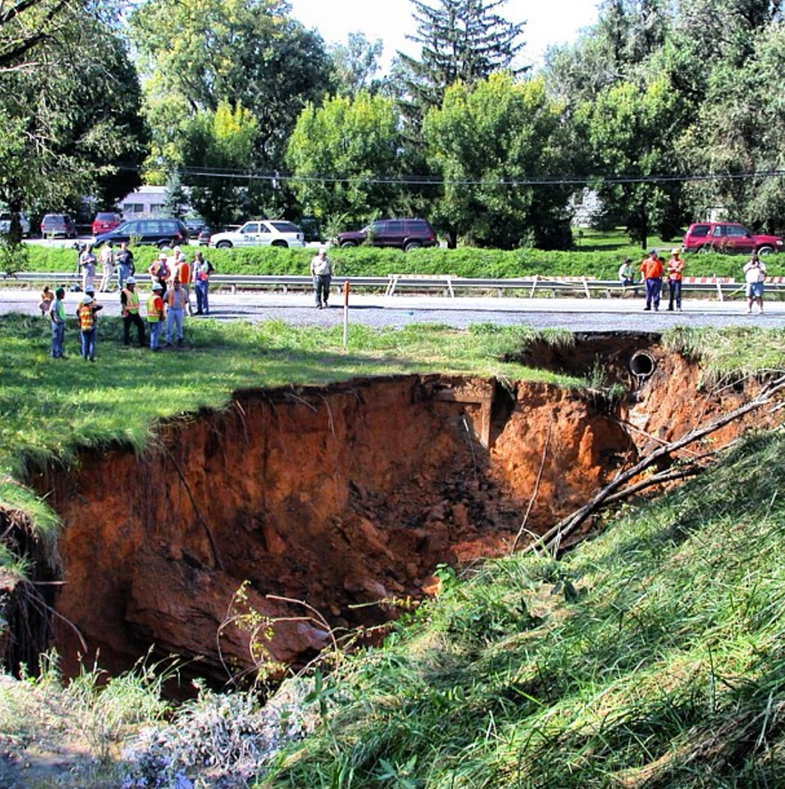What the heck are sinkholes, anyway?
A huge sinkhole opened in Japan. Where do they come from?

Last week, an enormous sinkhole opened up in the middle of a road in Fukuoka, Japan. The sinkhole, which measured nearly 90 feet wide, 100 feet long and 50 feet deep, may have been caused by construction work on a nearby subway line. Fortunately, no one appears to have been seriously injured.
Sinkholes are not usually as spectacular as the one in Fukuoka, but they can cause a lot of damage when they appear. Here’s what you need to know about what causes sinkholes, where they form, and why you shouldn’t fill the one in your backyard with garbage.
What are they?
When geologists refer to sinkholes, they’re usually thinking of holes that form naturally, rather than because of human interference (like subway construction). “The term is often used as sort of a catchall for things that are just ground collapses, but not all ground collapses are in geologic terms true sinkholes,” says Dan Doctor, a research geologist with the U.S. Geological Survey.
True sinkholes are most common in karst landscapes, areas where the underlying rock is made from limestone, gypsum or other material that can be dissolved by water. Over time, groundwater erodes the rock or sediment, forming channels and caves, which can eventually collapse. This is what happened in the National Corvette Museum in Bowling Green, Kentucky in 2014. “They built the Corvette Museum right on top of a fairly large cave passage,” Doctor says. “They didn’t know it, and the roof of the cave collapsed and destroyed several vintage Corvettes.”
This type, known as cover-collapse sinkholes, can appear suddenly. But more often sinkholes form slowly – without a dramatic collapse – as a bowl-shaped depression in the ground. Some develop over thousands of years, and can stick around even longer. “Sinkholes can be animal traps and we often find bones within features like that that go back millions of years,” Doctor says.
And not all sinkholes are gaping chasms. “There are sinkholes that you can step into by accident and just might swallow your leg, and there are sinkholes that can hold the Sistine chapel,” Doctor says.
Sometimes, collapses are also triggered by human activities. “Once you begin to develop and create infrastructure within karst areas…you disrupt the subterranean plumbing,” Doctor says. These manmade “sinkholes” are often caused by construction, mining, or leaking pipes. They can also happen when groundwater is pumped out to supply cities or for irrigation, or ponds are built to hold industrial waste, putting more weight on the supporting rocks below.
Where do they happen?
About 20 percent of the United States lies on karst terrain, making these areas vulnerable to sinkholes. Sinkholes are most common in Texas, Missouri, Kentucky, Alabama, Tennessee, Pennsylvania, and especially Florida.

Sinkholes may cause more than $300 million worth of damage each year in the United States. Some of the dangers associated with sinkholes are obvious—they can swallow up buildings and damage roads, and people and livestock occasionally fall in. But sinkholes also cause problems by draining lakes and wetlands. And sinkholes can collect polluted water, allowing it to seep into the underlying groundwater. So they can contaminate the underground stores that supply our drinking water and flow into streams. “People who fish for trout are often concerned about the quality of water coming out of springs,” Doctor says. “That tends to be highly sensitive in areas where there are sinkholes nearby.”
Sinkholes that appear on private property “quite often become the household dump,” Doctor says. This, he says, is not a wise move. “If they have a groundwater well nearby, they may be contaminating that well with their own waste.”
Sometimes, however, sinkholes can also make an ideal home for plants and animals by trapping cool air or offering shade from the sun. “They form little microclimates,” Doctor says.
Can we predict them?
While we can map which areas are more prone to sinkholes, it’s not really possible to pinpoint when a patch of ground will collapse. Part of the problem is that, to estimate risk, researchers need information about how many sinkholes have opened up over time. “Usually don’t have that information because…as soon as they’re formed they often get filled in and they may not even get reported,” Doctor says.
We do know that sinkholes seem to be tied to heavy rainstorms, hurricanes, droughts, and floods. “When there are large hurricanes that come and affect Florida, sinkholes are almost always problematic,” Doctor says. “With climate changing we might expect that could have some effect but…we don’t have data now to test that.”
There aren’t a lot of options for preventing a sinkhole from opening up on your property. However, “If you’ve done some kind of geophysical survey and you can detect the presence of an underground void, then yes, there are some things you can do,” Doctor says. Engineers might drill a small opening so the hole can be filled in. And if a house hasn’t been built yet, “They’ll probably excavate out until they get down to bare bedrock, and then place beams to cover the span of the void and build on top of that,” Doctor says.
And if you find yourself with a sinkhole in your backyard, a few states, such as Florida, offer ways to report a sinkhole, as well as tips for filling them in—after you’ve called your insurance company.
